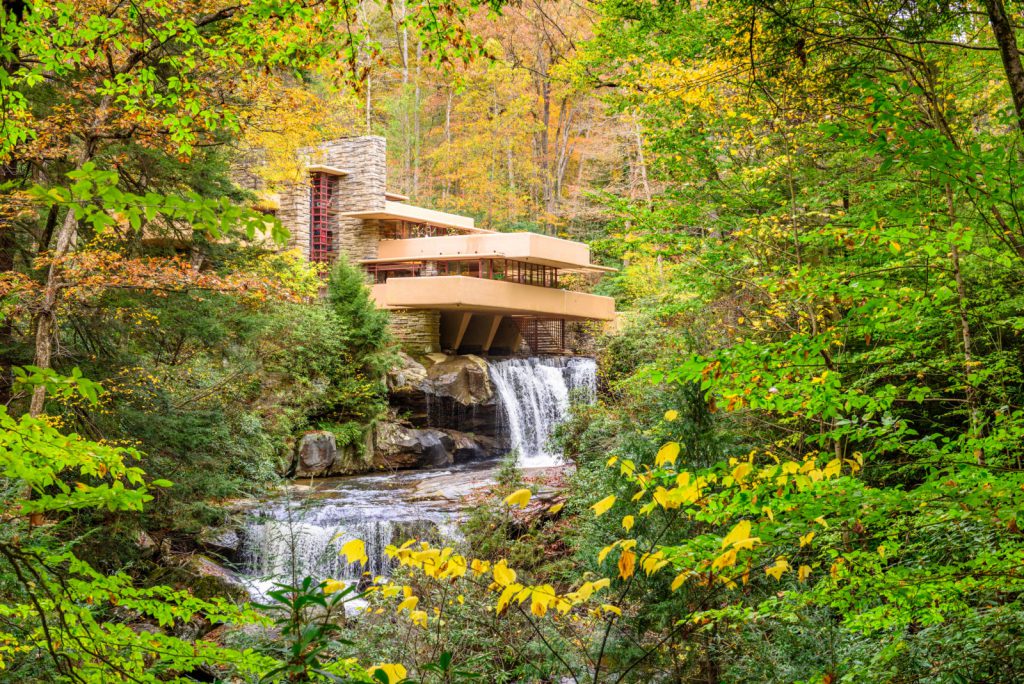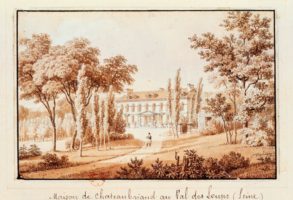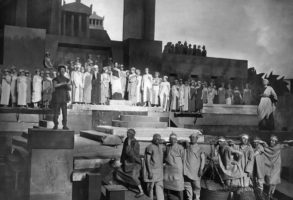
Published August 1, 2017
Claremont Review of Books - Summer 2017 issue
Depending on who was asking and when, Frank Lloyd Wright (1867–1959) was given to saying that he was the greatest American architect alive, the greatest American architect ever, the greatest living architect in the world, or the world’s greatest architect plain and simple, past, present, and future. When his third wife, Olgivanna, chided him for declaring in a court case that he was supreme among American builders, he answered mildly, “But I was under oath.” The famously nettlesome Philip Johnson, at the time still an architecture critic, was willing to allow that Wright was “the greatest architect of the nineteenth century.” This gibe did happen to be true enough; but Wright was also indeed the greatest architect of the 20th century, as Johnson would acknowledge in due course, when Wright had died and Johnson himself was the celebrity architect of the hour.
Big Plans
Frank Lincoln Wright was born 150 years ago on June 8, 1867, in Richland Center, Wisconsin, though he would habitually take two years off his stated age, like Tennessee Williams, who said the time he spent working in a shoe store didn’t count. Wright’s middle name was changed, probably by his mother, in honor of her Lloyd Jones family—“the God-Almighty Joneses,” as Wright’s sister remembered them years later. His mother, Anna, had big plans for her son while he was still in the womb: intending that he would become an architect, she put up prints of English cathedrals in what would be the infant’s room. Wright’s biographer Brendan Gill, in Many Masks: A Life of Frank Lloyd Wright (1987), suspects strongly that Anna Lloyd Wright was pretty well out of her mind, though Meryle Secrest, in Frank Lloyd Wright: A Biography (1992), treats her somewhat more generously as the architectural equivalent of the stage mother, and Ada Louise Huxtable, in Frank Lloyd Wright(2004), sees her as provoked to shrewish desperation by her husband’s perennial fecklessness.
But apart from a brief unpleasant interlude in snooty Massachusetts, Wright’s childhood and youth were those of a happy Wisconsin farmboy, who acquired lifelong habits of unrelenting work by learning to “add tired to tired,” as he later put it, and who exulted in the splendor of the natural world. In his solitary rambles in the wooded hills, as he dutifully rounded up the wandering cows for milking, one sees the origins of his architectural credo: the natural, organic, and integral—his favorite words to describe his work—are one, and they are sacred.
Wright learned as well from the “gifts” and “occupations” that were invented by the German educator Friedrich Froebel and that his mother bought for him. Froebel was a former crystallographer, and these were wooden blocks in various geometric shapes (cubes, cones, spheres, pyramids, etc.) to be arranged in as many configurations as a child’s mind could devise. As Huxtable writes, “Wright repeatedly credited these educational toys as the generators of his architectural forms…. One sees this source throughout Wright’s career, in his use of the rotated plan, the flipped mirror image, the hexagonal module, buildings designed in series as typical crystal chains.” Whether Anna Wright was in fact unstable or even deranged, she contributed mightily to making her son the architect she wanted him to be.
Wright went off to college fully intending to become an architect, but the University of Wisconsin had no school of architecture; he studied civil engineering instead. He did not last long at the university: only two and a half semesters, though he always claimed to have left just short of his degree. Chicago in the 1880s was the new frontier for American architecture, tearing down the jerry-built structures that had succeeded the disastrous fire of 1871, and rebuilding on a titanic scale, especially in the new commercial center. Huxtable exults with Trumpian vigor, “Great firms, Burnham and Root, Adler and Sullivan, Holabird and Roche, were engaged on great projects—office buildings, trade headquarters and mercantile exchanges, theaters, department stores, and the mansions of the new millionaires.” Wright headed straight for the boomtown. Steel as structural skeleton had opened novel possibilities for building tall and strong: the new skyscraper was “a proud and soaring thing,” in the words of master builder Louis H. Sullivan, and the fledgling Wright was already proud as an eagle and ready to soar.
He arrived in the city with seven dollars in his pocket and claimed to have survived on a banana a day while he looked for work, though he shelled out one exorbitant dollar to see his first ballet at the Opera House. Luxuries would always take priority over necessities, which he was sure would take care of themselves. On the fourth hungry day he approached the eminent J. Lyman Silsbee, who was building a Unitarian church in the Chicago suburb of Oak Park for Wright’s uncle Jenkin Lloyd Jones, and who had also built a Jones family chapel in Wisconsin that Wright himself had worked on and made a drawing of. Wright asserted with customary pride in his inviolable independence that he never mentioned the family connection to Silsbee and won the job strictly on the merits of his drawings. Wright’s recollections are littered with such dubious self-aggrandizing claims. Silsbee was a congenial boss who mostly designed Queen Anne houses and paid Wright less than he thought he was worth; Wright quit, came back, even got the raise he had wanted, then quit again, in search of bigger excitements.
He landed a position as a draftsman at Adler and Sullivan, where he would later say he was proud to have been the pencil in Louis Sullivan’s hand. Brendan Gill uncovers barely suppressed homosexual attraction between the two men, but the more pedestrian truth was probably a relationship of mutual admiration and mutual usefulness between the lieber Meister (dear Master), as Wright called him, and his subordinate. But no subordinate position, however exalted, would ever suit Wright’s own temperament.
When in 1889 Wright married the 17-year-old Catherine Tobin, who attended Uncle Jenkin’s church and whom he met at a costume party, he needed a family home of his own, and to meet his new responsibilities he secured from Sullivan a five-year contract and a loan to build a house in Oak Park. The late great architectural historian Vincent Scully of Yale demonstrated conclusively that Wright’s design for the façade of his house was lifted wholesale from published photographs of the Kent House in Tuxedo Park, New York, by Bruce Price, with an immense shingled gable that loomed like the Great Pyramid and a half-moon window capping a row of casements. Wright would never back down from lifelong insistence that his designs owed nothing to anybody, but his mastery derived in large part from encyclopedic cultivation; he took pains to know who was building what and where, and though he spread his contempt far and wide, when he saw something he liked, he remembered and put it to use.
He got all he could from Sullivan’s employ, but his love of extravagance and consequent chronic shortage of funds led him to defy the terms of his contract and design “bootleg” houses in his spare hours. When in 1893 Sullivan found out, he fired Wright in a rage, at first even refusing to hand over the deed to Wright’s house, which the cashiered underling had paid for in full. The two men would not speak to each other for 17 years, until Wright effected a sorrowing reconciliation when Sullivan was failing in health and business. In 1949, in his Genius and the Mobocracy, Wright paid tribute to Sullivan while launching an assault on everything he, Wright, hated in ancient and modern architecture and civilization.
Hearth and Home
In business for himself, soon with a crew of seven under him, Wright presently performed marvels—the Prairie Houses, which flourished during the first decade of the 1900s, pre-eminent among them; he built some 40. Despite their name, the Prairie Houses tended to go up in leafy suburbs, although bemused European architects such as Walter Gropius, studying lithographs of Wright’s work, gathered that they “stood in open country, in the Wild West of the Old World’s imagination,” as Gill writes. The acknowledged masterworks of the genre are the Darwin Martin House in Buffalo, New York (1905), and the Robie House in Chicago’s Hyde Park (1909). The latter, with its elongated “ship of the prairie” lines, its roof cantilevered 20 feet beyond any supporting masonry, and its baffling arrangement of planes, has been likened to the Cubist paintings by Pablo Picasso and Georges Braque being done at the same time.
The Prairie Houses were innovative in several respects, which Wright enumerates in Modern Architecture (1931). Horizontal lines emphasized each house’s intimate connection to the ground. Conventional rooms, “boxes beside or inside other boxes,” were replaced by large open spaces, in which living room and dining room became one. Basement and attic were abolished; the dormer disappeared. Structure was made appropriate to material, with brick, stone, or wood each put to its own natural use. “Light screens” of stained glass—angular abstractions of flowers and trees—filled long expanses of exterior walls. Proportions adhered to a human scale, based upon Wright’s own (somewhat exaggerated) 5’ 8½” height. Furnishings were all of Wright’s own design, “in simple terms for machine work,” with “straight lines and rectilinear forms.” Decorators were sent packing. The fireplace, the domestic hearth, became the centerpiece of the home, indicative of the cult of the wholesome family that figured so largely in Wright’s mind and heart. In Gill’s eloquent words, “It was not the actual prairie that these houses summoned up, but the expression of some essential goodness in family life that could be imagined as existing (or as having once existed) on the American prairie.”
But by 1909 Wright had had his fill of his own marriage, which he saw as sacrificing honorable passion to musty respectability. Catherine was a most respectable matron by now; the couple had six children, and the warm thrill of young love had become the cool decorum of middle age. Renewed heat came from Mamah Borthwick Cheney, only two years younger than Wright, the wife of a client, mother of two children, a beauty and a person of refinement with a master’s degree in teaching who translated Goethe’s poetry. Wright and Mamah set tongues wagging in Saints’ Rest, as he called churchly Oak Park, when they sped around town together in his convertible, the Yellow Devil. In due course they abandoned their respective spouses and children and ran off to Europe. A delirium of public moral outrage ensued. As Meryle Secrest writes, “ever since the architect Stanford White was shot and killed by Harry K. Thaw over a scandal involving the latter’s wife in 1906, journalists had been alerted to the exciting possibilities provided by the world of architecture; here was an almost parallel case.”
The very public adultery was costly. One learns from Roy R. Behrens’s new book, Frank Lloyd Wright and Mason City: Architectural Heart of the Prairie, that while an up-and-coming Iowa town prized Wright’s architectural innovations at first, it banished him once his marital infidelity hit the news; he had designed a Prairie House for a local doctor in 1908, and the City National Bank and Park Inn in 1909, the jewels of the town center, but the project for another house there fell through because the client had no truck with adulterers, and influential townsmen informed Wright he was unwelcome in Mason City henceforth. (The town sufficiently esteemed both the skill and the morals of Wright’s sometime associate Walter Burley Griffin, and he was commissioned to build a cluster of Prairie Houses in one fortunate neighborhood, thereby enhancing Mason City’s genuine architectural distinction.) Wright’s services were not much welcome anywhere else either.
Building Against Doomsday
Disgraced in most everyone’s eyes but his own and his lover’s, Wright would return to his family, but only provisionally, while Mamah waited in Berlin for her divorce, initiated by her husband, to come through on grounds of desertion. Catherine for her part refused to divorce Wright, and he decamped from Oak Park in 1911 to the house and haven he had built for himself and Mamah in Spring Green, Wisconsin: Taliesin, named after a legendary Welsh bard, and meaning “Shining Brow.” No one has described Taliesin better than Wright in his Autobiography.
I knew well that no house should ever be on a hill or on anything. It should be of the hill. Belonging to it…. Taliesin was to be an abstract combination of stone and wood as they naturally met in the aspect of the hills around about. And the lines of the hills were the lines of the roofs, the slopes of the hills their slopes, the plastered surfaces of the light wood-walls, set back into shade beneath broad eaves, were like the flat stretches of sand in the river below and the same in color, for that is where the material that covered them came from…. The whole was supremely natural…. Walls opened everywhere to views as the windows swung out above the treetops, the tops of red, white, and black oaks and wild cherry trees festooned with wild grape-vines. In spring, the perfume of the blossoms came full through the windows, the birds singing there the while, from sunrise to sunset—all but the several white months of winter.
Wright depicts a perfect erotic bower for perfectly happy lovers, but the idyll would come to a horrifying end. In August 1914, while Wright was working on the Midway Gardens entertainment complex in Chicago, a servant in a spasm of psychotic violence set the house on fire and slaughtered seven people with an axe as they fled. Mamah and her two children were among the dead. The house was destroyed, and Wright devastated.
Heroically resilient, Wright rebuilt his house and his life—and he rebuilt Taliesin yet again after an electrical fire in 1925. His next great love proved disastrous, however: Miriam Noel, an artsy widow and morphine addict allured him with a letter of passionate commiseration soon after the murders. Their exceedingly ill-advised marriage in 1923, the same month he finally got his divorce from Catherine, fell apart in a harrowing rush of mutual beastliness. Though Miriam left him soon afterward and he sued her for divorce a year later, she would haunt him like a malign specter after he fell in love with Olgivanna Lazovich Milanov. Milanov was a Montenegrin beauty 30 years younger than Wright, an acolyte of the dubious mystic G.I. Gurdjieff, and still another man’s wife when she met the architect, and they promptly began an affair. Wright would marry her in 1928, after another scandal-plagued beginning. Olgivanna proved an invaluable partner and this marriage lasted the rest of his life.
In the years soon after the Taliesin bloodbath, Wright was “building against doomsday,” as he later put it. The Harvard scholar Neil Levine, in his magisterial tome The Architecture of Frank Lloyd Wright(1996), argues persuasively that Wright in his psychic distress turned aside from his passion for “architecture at one with a benevolent landscape” and deliberately sought out sites of unpredictable natural peril in the earthquake zones of the Pacific Rim. His Imperial Hotel in Tokyo (1913–1923), which Wright compared to “a super-dreadnought” built to float unharmed on immense seismic waves, was a triumph of innovative engineering with its foundation of cantilevered slabs on a sea of mud; and the hotel survived the 1923 Great Kanto earthquake, the most catastrophic in Japanese history, killing 100,000 and nearly obliterating the capital city.
Meanwhile, Wright was working on the Hollyhock House (1916–1921) on a Los Angeles hill for a theatrically inclined heiress, Aline Barnsdall; it resembles nothing so much as a Mayan temple or palace transmogrified by Hollywood stardust, and Wright called it “pure California.” He would open a Los Angeles office in 1923, and would build four “textile-block” houses nearby in this new archaic Mesoamerican style, employing four-inch-thick concrete tiles reinforced by steel rods and decorated with machine-incised designs. The most famous is the Alice Millard House in Pasadena, “La Miniatura,” and they all show how far he had come from the Prairie.
Modernity and Genius
The later 1920s and early 1930s, however, were Wright’s wilderness years; he was simply not in demand, with a gamy personal reputation and defiant singularity as a builder. Some imposing projects for clients who did want his services were scuttled by the Depression. He wrote and lectured, and founded the Taliesin Fellowship, for which apprentices paid higher tuition than at Harvard and performed menial labor for the Master while they learned what they could from his presence and example.
Then in 1937, when he was 70, came his most spectacular success. He completed a weekend house literally right over a waterfall on Bear Run in the wilds of Pennsylvania for the Pittsburgh department store owner Edgar J. Kaufmann, father of a former Taliesin apprentice, and it became the most famous house in the world: Fallingwater. Wright demonstrated an unprecedented skill with the cantilever: three balconies of steel-reinforced concrete projecting one over the other, the second extending out past the first, without visible means of support, and beautifully recapitulating the natural cantilever of the waterfall’s projecting stone. The effect of the exterior has been compared to the balance and imbalance of cubist sculpture. Indoors, in the cavernous yet intimate multi-purpose main room, the waxed flagstone floor evokes moving water over a rocky bed, the fireplace hearth is a boulder emerging through the floor that Mr. Kaufmann loved to sit on before the house was built, and a hatch opens to a stairway down to the water above the falls. Nature is sovereign here, and in its accommodating beneficence permits human beings to make an ideal shelter for themselves.
For Fallingwater is the sacred meeting place of inhuman magnificence and human will: the wilderness making room for man on terms agreed to by both of them. The house was Wright’s reaction to the International Style that Philip Johnson and Henry-Russell Hitchcock had so winningly promoted and that had ousted him as a recognized modern genius. Here were modernity and genius never seen before. It had its imperfections: the cantilevers deflected, or drooped, over time, and required elaborate shoring up in 2002, without which the house would have collapsed. But the achievement was heroic, and Wright was lionized for it: he became the first architect to make the cover of Time,and his faltering career was rejuvenated.
The momentum of this accomplishment propelled Wright through two more hard-working decades. The 1937 Johnson Wax Building in Racine, Wisconsin, features a workroom of cathedral-like grandeur, once again summoning the natural world indoors, with support columns like lily-pads on their stalks, and diffused light from above imparting a delicious underwater feel. In 1938 Wright received a commission to design the campus for Florida Southern College, and would continue work on this large project until completion in 1953. In the late 1930s he built the first Usonian Houses (Usonia being his preferred name for the United States of America, which he thought an unduly proprietary title), for modest people on modest budgets.
During the 1940s he constructed Taliesin West in Arizona’s Sonoran Desert, the new winter home for himself and the Fellowship, rich in associations with the primordial landscape and the region’s indigenous Hohokam people. In 1943 he began work on a museum in New York City—the place he hated above all others—to house Solomon R. Guggenheim’s art collection. The Guggenheim Museum on Fifth Avenue would not be completed until 1959, several months after Wright’s death, but like Fallingwater it too made him more famous than ever before. Notorious, too, because distinguished critics such as Lewis Mumford and Hilton Kramer savaged the building as an exercise in unpardonable vanity, unsuitable as an art museum and made principally to call attention to itself and its maker. But in fact it is another gem: a spiral ziggurat, or taruggitz, as Wright called it, for it inverted the Mesopotamian original, each ascending story extending farther out than the preceding. Wright would also compare it to the chambered nautilus, for the building’s “harmonious fluid quiet” was the perfect ambience for these often startling modern paintings. Nature always had the final say.
Levelling Opponents
And those who failed to honor Nature as Wright understood it earned his everlasting opprobrium. Wright lived and built in opposition to convention, and he habitually tried his damnedest to level his opponents. His impressive and voluminous writings, published by Rizzoli and collected in five volumes, are full of polemical conniptions and extravagances.
In “The Art and Craft of the Machine” (1901), a speech given at Jane Addams’s Hull House, he extols the superb artistry of William Morris (1834–1896)—arch-priest of the English Arts and Crafts Movement. But Wright goes on to insist that Morris in his passion for handmade beauties missed an essential virtue of modern civilization: “the machine was the great forerunner of Democracy.”
“[T]he engine, the motor, and the battleship,” Wright enthuses, are
the works of art of the century! The Machine is Intellect mastering the drudgery of earth that the plastic art may live; that the margin of leisure and strength by which man’s life upon the earth can be made beautiful, may immeasurably widen; its function ultimately to emancipate human expression!
The machine serves the true nature of wood far better than handicraft does,
by its wonderful cutting, shaping, smoothing, and repetitive capacity, [making] it possible to so use [wood] without waste that the poor as well as the rich may enjoy today beautiful surface treatments of clean, strong forms that the branch veneers of Sheraton and Chippendale only hinted at, with dire extravagance, and which the Middle Ages utterly ignored.
So too steel and iron and concrete are responsible for unexampled architectural wonders, and modern casting in metal and electro-glazing improve vastly upon time-honored techniques that are now backward. Thus Wright unfolds the paradox—if it is a paradox—that following Nature now means getting wise use out of the machine; his heroes Walt Whitman and Ralph Waldo Emerson considered the human conquest of Nature a natural process. Wright returned frequently to this praise of machine art and craft throughout his career, but muted certain aspects of his enthusiasm, under pressure of architectural and cultural developments.
Unafraid of traditional pieties, he treated with irreverence the architecture of the Greeks, the Romans, the Renaissance, the neoclassical, the “pseudo-classical” Beaux Arts, and just about everything built in the modern world that had been put up by anyone but him. For example, he scorned the “trabeated” construction of the Greeks, their endless repetition of the post and lintel, a vertical support topped by a horizontal member—all they knew of technique. In Genius and the Mobocracy he indicts the ancients for building as they did because their political orders and intellectual fundamentals were vicious: “No—there could be nothing in the culture of incestuous Greece and bloody Rome to inspire organic structure in building, statesmanship, or philosophy—or for a culture true to democracy in the realm of aesthetics, the realm of ethics, or religion.”
If the classical world was so ignominious, then the efforts to resuscitate its putative architectural glories were degraded many times over. From “Architecture and Modern Life” (1937):
When Michelangelo piled the Pantheon upon the Parthenon and called it St. Peter’s, he, a painter, had committed architectural adultery. It was destined to bring forth a characteristic monstrosity, namely, an arch set up into plain air on posts to shift for itself. It is an imitative anachronism that characterizes our public acts, as illustrated by our capitols, court houses, and town halls…. The same depravity sees a Greek temple as fitting memorial to Abraham Lincoln. He is the Greek antithesis. Nothing is Greek about his life or work or thought…. Any Roman bath or sarcophagus will do to lend prestige to the sacrosanct bank on any town sidewalk anywhere.
In Wright’s eyes the Beaux Arts architects in America, many of them trained in the Parisian school of that name, rehearsed the ancient forms to no good end and represented the truckling of the New World to the Very, Very Old. The New York firm McKim, Mead & White and Chicago’s Daniel Burnham were the Beaux Arts’ very best of the best, and they did their worst to subjugate American democracy to outworn imperial ideals that Wright saw as an utter disgrace. In building Pennsylvania Station the New Yorkers appropriated quite inappropriately the Baths of Caracalla, and they turned Columbia University’s Low Memorial Library into a Pantheon look-alike. They were renowned for the magnificence of their building, which to unbelievers such as Wright confused costumed ostentation for elegance.
Other Rivals
In time the Beaux Arts would be superseded by the International Style as Wright’s contemporary nemesis. In the 1920s the vogue in architecture became a formulaic starkness, European in origin, often colored by socialist predilections, with buildings box-like in plan, favoring straight lines and flat roofs, and averse to ornament—the Viennese architect Adolf Loos declared, “Ornament is Crime.” The stars of the new day included Walter Gropius, Ludwig Mies van der Rohe, and Le Corbusier. Mies asseverated that his ideal design was “beinahe Nichts,” almost nothing, and his dictum “Less is more,” first intimated to Philip Johnson, gained widespread credence. Wright disparaged the essence of the International Style as “negation.” Le Corbusier’s proclamation that “A house is a machine for living” violated Wright’s building code of allegiance to Nature even when machine art and craft were involved. Wright derided Le Corbusier’s Villa Savoye, widely considered his domestic masterpiece, as “a box on stilts”; and he couldn’t have been more right.
Yet as Hugh Howard writes in his fascinating new book, Architecture’s Odd Couple: Frank Lloyd Wright and Philip Johnson, Mies’s first great achievement, the 1930 Tugendhat House in Brno, Czechoslovakia, might not have looked like a Wright product but it owed a significant debt to his designs. Mies deployed interior steel support posts so that the need for interior walls was obviated and exterior walls were not burdened with load-bearing, thus making possible both a wide-open interior and curtain walls of endless glass. Johnson’s understanding of Mies’s perfection, however, was doubly inimical to Wright. The Tugendhat House “is without question the best looking house in the world,” Johnson wrote to his colleague Henry-Russell Hitchcock. “[It] is like the Parthenon.”
Despite an obvious rivalry—obvious to Wright at any rate—Mies was the only exponent of the International Style whom Wright treated with any warmth. He entertained the new immigrant royally at Taliesin, and Mies responded gratefully, “This is a kingdom.” When Wright collided with Gropius in a chance encounter, on the other hand, he treated this other refugee from Nazism with coarse brusqueness; and when Le Corbusier was touring America and asked to come see Wright at Taliesin, he flatly refused.
Philip Johnson was a special case. At their worst he and Wright engaged in hot reciprocal animadversions, and at his best Wright subjected him to jovial belittling. Wright had scant regard for the 1948 Glass House that Johnson built for himself in New Canaan, Connecticut—a blatant knock-off of Mies’s Farnsworth House in Plano, Illinois—and that made Johnson an architectural celebrity. Yet it was Wright who told Johnson that he had to choose between being a critic or an architect, and thereby gave him the push he needed to pursue his vocation. And late in life, after Wright’s death, Johnson, lauded by then as America’s foremost living architect, would confess that early on he didn’t realize how good Wright was, and declared him “the greatest architect of our time.” Johnson did give himself some indirect credit for Wright’s supreme success: “Wright really built the Edgar Kaufmann house, Fallingwater, as an answer to our 1932 show at the museum—as though he were saying, ‘All right, if you want a flat roof, I’ll show you how to really build a flat roof.’” But Johnson’s most lavish homage to Wright acknowledges the Master’s singular achievement as purely his own: he was “the type of genius that comes along only every three or four hundred years.”
So Much Beauty
It is one of the privileges of genius to be ever aware of its superiority. It is one of its most disfiguring flaws to be unsparing in its contempt for lesser men or even its rightful peers. Wright believed himself the only architect truly to appreciate American democracy, and he thought architecture so significant that this made him the greatest American democrat all told. In the path-breaking Sticks and Stones: A Study of American Architecture and Civilization (1924), Lewis Mumford, who thought Wright the supreme architect of his time, nevertheless finds worthy the showpiece architectural settings that Wright despised and that distinguished statesmen desired to enhance their deeds. To build in the classical manner then was not pastiche or parody for the founders; they embodied the classical virtues, which contrary to Wright’s fulminations were formidable. The beauty and integrity of Monticello and the University of Virginia rival those of Wright’s masterpieces.
And the Parthenon, the Pantheon, and St. Peter’s do not exactly deserve to be dismissed. Frank Lloyd Wright was the kind of genius who recognizes no one’s excellence but his own. Perhaps such outlandish self-regard was what it took to sustain him through years of intense personal pain and drive him to become the protean creator of so much beauty. Profoundly damaged men sometimes do extraordinary things, and there is now general agreement that Wright was the greatest architect of the 20th century—the greatest since Thomas Jefferson, maybe since Christopher Wren or Michelangelo. Of course such lavish honor would still not be quite enough to satisfy him; he expected to be known as the best, period.
Algis Valiunas is a fellow at the Ethics and Public Policy Center.








